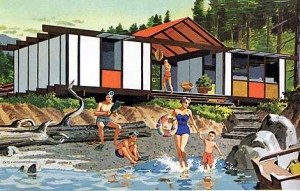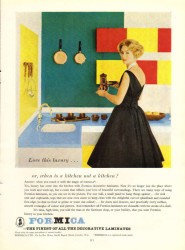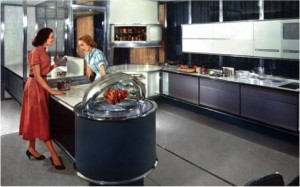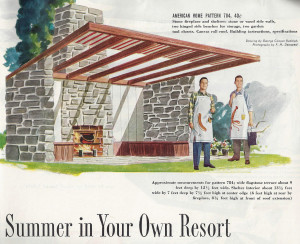There’s a great future in plastics. Think about it. Will you think about it? – Mr. McGuire in The Graduate (1967)
On May 14th Restore Oregon will present the Mid-Century Modern House of Tomorrow Tour. The tour focuses on the mid-century, but the “House of Tomorrow” premise has been with us since at least the early 1900’s. The many World’s Fairs and Expos over the decades have presented conceptual homes featuring innovative materials, construction systems, and fittings to entertain fair-goers – and above all to promote industry.
 The post-WW2 homes on the tour showcase many aspects of this future-focus. For some, advertising played a key role in “branding” them for consumer appeal and mass production. Some are part of developments that represent the emerging suburban ideals – cul-de-sacs, green spaces, and the ever present automobile. Others are inserted into existing urban fabric and are unabashedly different – flaunting their modernity and thumbing their noses at their more traditional neighbors.
The post-WW2 homes on the tour showcase many aspects of this future-focus. For some, advertising played a key role in “branding” them for consumer appeal and mass production. Some are part of developments that represent the emerging suburban ideals – cul-de-sacs, green spaces, and the ever present automobile. Others are inserted into existing urban fabric and are unabashedly different – flaunting their modernity and thumbing their noses at their more traditional neighbors.
From the Sears Catalogue homes of the nineteenth century to the current vogue for high-end prefab homes, prefabrication and mass production is a constant theme in American home design, its promotion ebbing and flowing with market surges. Post-war interest in prefabrication was driven in part by the industries that had grown to serve the war effort and now looked for new markets.
 Post-war America saw the GI Bill and an enormous upswing in development and home ownership. Materials and labor resources were abundant and affordable once again, and new homes showcased the innovation brought about by the war effort. No longer primarily needed for plane making, aluminum was now used for windows and siding, and was promoted heavily. Plastics, a fairly new material, became commonplace particularly for flooring and countertops. Technology – including lighting controls, built-in audio systems, and complex heating and cooling systems – replaced ornamentation in design, and brought a machine quality to the homes. Technologies generated for war inspired the features and aesthetic of our home appliances as well, with aerodynamic lines, automation, controls panels, and the ability to retract when not in use.
Post-war America saw the GI Bill and an enormous upswing in development and home ownership. Materials and labor resources were abundant and affordable once again, and new homes showcased the innovation brought about by the war effort. No longer primarily needed for plane making, aluminum was now used for windows and siding, and was promoted heavily. Plastics, a fairly new material, became commonplace particularly for flooring and countertops. Technology – including lighting controls, built-in audio systems, and complex heating and cooling systems – replaced ornamentation in design, and brought a machine quality to the homes. Technologies generated for war inspired the features and aesthetic of our home appliances as well, with aerodynamic lines, automation, controls panels, and the ability to retract when not in use.
 Appliances are key characters in these houses. Post-war households saw less hired help, and time-saving appliances were touted as the way of the future. And as returning GIs replaced (and displaced) women in the workforce, a woman’s place was promoted as commander of her own high-tech kitchen-centric home. Advertising of this period often shows immaculately dressed women preparing meals at the touch of a button – entertaining effortlessly, as the cocktails flowed.
Appliances are key characters in these houses. Post-war households saw less hired help, and time-saving appliances were touted as the way of the future. And as returning GIs replaced (and displaced) women in the workforce, a woman’s place was promoted as commander of her own high-tech kitchen-centric home. Advertising of this period often shows immaculately dressed women preparing meals at the touch of a button – entertaining effortlessly, as the cocktails flowed.
 After austerity, entertaining was a spoil of the war that included traditional formal business dinner and cocktail parties, as well as less formal gatherings. The quintessential American barbecue became central to family life in the summer months, and indoor spaces became fluid with outdoor spaces for complete freedom of movement. Courtyards and patios protected the family realm from public invasion, and allowed for full enjoyment of this new prosperous and future focused lifestyle.
After austerity, entertaining was a spoil of the war that included traditional formal business dinner and cocktail parties, as well as less formal gatherings. The quintessential American barbecue became central to family life in the summer months, and indoor spaces became fluid with outdoor spaces for complete freedom of movement. Courtyards and patios protected the family realm from public invasion, and allowed for full enjoyment of this new prosperous and future focused lifestyle.
The “House of Tomorrow” may be prefabricated, but its outdoor spaces are equally important. Decks and patios extend the living spaces and, in the NW climate, often benefit from generous overhangs for shade and shelter.
Now these futuristic homes are themselves historic. The optimism in design remains intact, and offers us insight in to this period of American history, and how we have changed as a culture. Join us in a tour which celebrates the Houses of Tomorrow.
In addition to spotlighting Mid-Century architecture, the goal for our tour is to draw attention to the need for thoughtful preservation of Modern architecture. Homes on the tour may have been lovingly restored, but there are so many more Modern buildings whose historic significance remains unrecognized, and are very much in need of stewardship.
There will also be a companion talk The Mid-Century House: A Vision of Tomorrow the evening prior to the tour.
Friday, May 13th at 7:00 pm. | Central Lutheran Church, Portland
$10 – $15
Our program will provide insights into the elements that represent the vision of tomorrow in the houses on the following day’s tour as well as discussions about post-war design, materials and gadgetry.
The talk will once again take place in the beautiful Pietro Belluschi designed Central Lutheran Church with a new larger screen for a clear view of the presentations.
**Tour ticket holders who attend the talk will be able to check in and receive their tour booklets at the Friday evening talk, bypassing Saturday morning registration.

